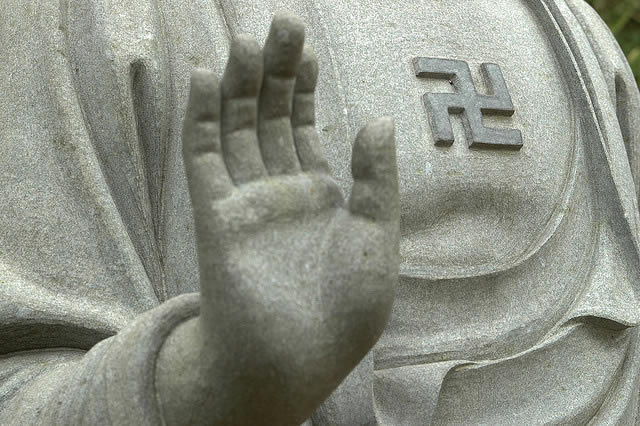
Swastika on a Buddha statue. Photograph by Fernando Mafra
This is a response to the previous article published on The Descrier entitled Buddha, Space, Meteorites and Nazi Science by Heather Pringle.
Perhaps some journalists would not have been misled about the “Buddha from Space” had they read the detailed historical and cultural evaluation of it in the research paper “The Lama Wearing Trousers: Notes on an iron statue in a German Private Collection”, by Achim Bayer of Dongguk University, Seoul, Korea. His conclusion, in collaboration with many experts in these fields is that the statue has:
“a number of stylistic features that undoubtedly identify this statue as a European-made imitation of Tibetan art… it is a counterfeit… produced as home decoration, for film sets and the like… an image [that]has been liberally copied by a well-trained western sculptor who had no background in traditional Tibetan art.”
The speculation of the authors of the original paper: “The Buddha from Space” (September issue ‘Meteorics & Planetary Science’), admit to having no knowledge of the Schaefer Expedition which raises the question as to why they did not contact relevant experts on either Buddhist iconography or Tibetan culture. It is possible that whoever sold the statue, gave a hint that the object was linked to the Nazi regime in order to increase its price when it came to be sold. It is astounding that no source reference whatsoever, not even hearsay, was made by planetary science authors for its provenance. So how can they possibly have linked it to Schaefer?
Maybe the answer is as follows: Even without any indication of any provenance, how utterly irresistible it must have been for some to conjure up out of thin air yet another Nazi–Tibet fantasy – why not link it to the Schaefer expeditions! About Schaefer, claims have been made that he was ‘possessed’ to find the origins of the Aryan race (one presumes in the Third Reich sense?), and that he went to endless trouble to find their ‘noble, master race’ descendants who had spread far and few across the roof of the world.
Maybe I am missing something here, but having searched all of Schaefer’s books on his earlier journeys in China and Tibet (twice under the direct leadership of the American zoologist Brook-Dolan from the Academy of Natural Sciences Philadelphia), all I can find is a task allotted to Gordon T. Bowles, an American archaeological ethnologist, who gave himself the task of measuring skulls of the main groups of Mongolian peoples to determine the anthropological subdivisions of the race (page viii, in the introduction to “Berge, Buddhas und Baeren” – [Mountains, Buddhas and Bears], Berlin 1933). On page 11, Schaefer describes the physical characteristics of these people. However, I find no comments on Aryans or any Master Race in the books or papers. Perhaps someone can provide original documents to prove otherwise? Since I started research on Schaefer in 1998, at the suggestion of a British diplomat who met him in Tibet, nobody has been able to produce any such original material. Perhaps those who do not speak German get confused – maybe they mistranslate “Hauptrasse” on pages viii and 10 (cited above) as “master race”? It actually means ‘main race’.
To state that later in 1938/39 Schaefer had a fervent desire to bring back more evidence of old Aryan symbols is wide of the mark. Out of more than one thousand photographs of Tibet, there is the sum total of three, which have the Swastika in them. To the intense annoyance of the archivists in Germany where the photographs are stored, some journalists, who request no other images from the collection in recent times, have used this paltry number to claim that Schaefer was ‘obsessed’ by the symbol.
The next question is – where is the evidence of the meteorite experts that the research goal of Schaefer’s 1938/39 expedition was “ordered by the German National Socialist government…to find the roots of the Aryan religion and the Aryan origin”? For such evidence, we have been left in the dark. Luckily, academics of other subjects have provided the facts.
Although the “German Tibet Expedition” was planned as a scientific mission (see The Times, 31st July, 1939, issue 48371, page 15: “The expedition is bringing back valuable zoological and botanical collections”), it was caught up in the politics of the time. Indeed it was Himmler and not Schaefer, who was attached to a strange mixture of mystical and esoteric illusions about “Aryan overlords in the Himalayas”, and Himmler had a real interest in Tibet. He gave his support to the expedition although he wanted to impose his strange ideas on its objectives. Schaefer’s vehement refusal to accept Himmler’s plans led, eventually, to the expedition not being sponsored by Himmler’s SS or its organisations “because it would lie outside the scope of his work” [Bundesarchiv Berlin, NS 21/682, 23rd January 1938]. Schaefer continued to accept political support, however, and had to compromise because he was dependent upon Himmler’ support to obtain passports and visas, via London, for the then British India. The primary aim of this expedition was an holistic creation of a complete biological record of Tibet alongside a synthesis of inter-relating natural sciences with regard to geography, cartography, geology, earth magnetics, climate, plants, animals and mankind (for which one can refer to Schaefer’s foreword in his book of 1943, pages 7 to 16 as well as to full details in German and British archives).
A British eyewitness account relates:
“We reached Tangu next day, 4th July… I was hospitably received by Dr. Schaefer’s party who were spending several months in Sikkim collecting birds, insects, and plants… Schaefer’s party comprised every breed of scientist known to man: ornithologist, zoologist, entomologist, anthropologist, and many other ‘ologists’. I took the anthropologist on one side and abjured him to spare no pains in tracking down homo Nivis odiosus, the ‘Abominable Snowman’, and begged him not to be discouraged by the zoologist [Schaefer], who would certainly tell him that the tracks he was following were not those of our abominable friend, not even a Snark, nor a Boojum, but a bear.”
Schaefer gave an insight to the suspicions against him at time in his address to the Himalaya Club in Calcutta, 1939:
“We did not find any gold, nor did we find any oil…. But the newspapers in India, as well as in England … were full of untrue stories about these things and full of suspicion against us. Headlines such as “Hitler’s Delegation in Tibet found oil” appeared. But they did not surprise us any more after a while. Our tents sometimes vibrated with roaring laughter, when we read such articles, but we also learned, what the great freedom, by which any person is allowed to express his noble private ideas in the press, actually means, and I also experienced what damage this does to friendly scientific relationship of different countries.”
In conclusion, the main question still remains, namely, what does Schaefer have to do with the recently discovered meteorite “iron man Buddha statue from outer space”? What evidence is there that it was collected in Tibet by Schaefer? The answer is: none at all; that is fact… but doubtless were they still alive today their tents would still be vibrating as they roared with laughter upon reading such new articles once again!
For further reading see:-
Ernst Schäfer (1910-1992) – from the mountains of Tibet to the Northern Cordillera of Venezuela: a biographical sketch
Tibet in 1938–1939: The Ernst Schäfer Expedition to Tibet
Schäfer Lecture on the 25.7.39 by Dr. Ernst Schaefer at the Himalaya Club, Calcutta (2)
Written by Roger Croston





1 Comment
Actually, the main question now is, who made this statue and why, and where it’s gone now (whose private collection, exactly) and why….